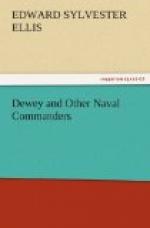Of course the Spanish spies were on the watch in Hong Kong, and while the American squadron was steaming out of the bay the news was telegraphed to the authorities at Manila, who knew that the real destination of the enemy was that city. Every effort was made to keep the matter a secret, but it was impossible, and it soon became known to everybody that the American “pigs” were coming, and that Manila must fall, if the Spanish fleet were unable to beat off the enemy.
The Spaniards proclaimed that they would send every one of the American vessels to the bottom; but they had made similar boasts before, and their bombast did not quiet the fears of the people, among whom a panic quickly spread. Those who were able to do so gathered their valuables and took refuge on the merchant ships in the harbor and thanked heaven when they bore them away. Many others fled from the city, but the majority stayed, grimly determined to be in at the death and accept whatever fate was in store for them.
The distance between Hong Kong and Manila is 630 miles, and it needed only a little figuring on the part of the inhabitants to decide that the dreaded squadron would be due on the following Saturday evening or early the next morning, which would be the first of May. The self-confidence of Admiral Montojo and his officers was almost sublime. All they asked was a fair chance at the “American pigs.” They hoped that nothing would occur to prevent the coming of the fleet, for the Spaniards would never cease to mourn if the golden opportunity were allowed to slip from their grasp. They were not disappointed in that respect.
It is proper to give at this point the respective strength of the American and Spanish fleets. The squadron under the command of Commodore Dewey was as follows:
Olympia—Protected cruiser (flagship), 5,500 tons. Speed, 21.7 knots. Complement, 450. Armor, protected deck, 2 inches to 4-3/4 inches. Guns, main battery, four 8-inch, ten 5-inch, rapid-fire; secondary battery, rapid-fire, fourteen 6-pound, seven 1-pound, four Gatlings, one field gun and five torpedo tubes. Captain Charles V. Gridley.
Baltimore—Protected cruiser, 4,400 tons. Speed, 20.1 knots. Complement, 386. Armor, 2-1/2 inches to 4 inches. Guns, main battery, four 8-inch, six 6-inch, slow-fire; secondary battery, rapid-fire, four 6-pound, two 3-pound, two 1-pound, four 37 MM. Hotchkiss, two Colts, one field gun and five torpedo tubes. Captain N.M. Dyer.
Raleigh—Protected cruiser, 3,213 tons. Speed, 19 knots. Armor, 1 inch to 2-1/2 inches. Guns, one 6-inch, rapid-fire, ten 5-inch; secondary battery, eight 6-pounders, four 1-pounders, and two machine guns. Complement, 320. Captain J.B. Coghlan.
Boston—Protected cruiser, 3,189 tons. Speed, 15.6 knots. Complement, 270. Armor, 1-1/2 inch deck. Guns, main battery, two 8-inch and six 6-inch rifles; secondary battery, rapid-fire, two 6-pounders and two 3-pounders. Captain F. Wildes.




